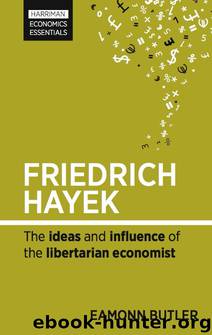Friedrich Hayek: The ideas and influence of the libertarian economist by EAMONN BUTLER

Author:EAMONN BUTLER
Language: eng
Format: epub
ISBN: 9780857192301
Hayek versus Keynes
Nothing caused more disagreement between Hayek and John Maynard Keynes than this point. Keynes did not see a slump as the inevitable consequence of an earlier boom; he put it down to problems with the capitalist system itself. His solution was to boost ‘demand’ – the willingness and ability of people to buy things – including ‘investment demand’ for capital goods, something he thought was essential to generate new production and employment.
But in Hayek’s view this expansionary policy leads only to greater disaster. The problem is not a shortage of investment, but malinvestment – investment that has gone to the wrong places. It is not a shortage of demand, but a mismatch between demand and supply. Artificially low interest rates have prompted business to commit real resources to unsustainable projects that are designed to produce things that people no longer want or can afford.
Keynes therefore makes a crucial mistake in wanting to boost ‘demand’ or ‘investment’. He is looking only at the totals of what people buy or invest, not what they want to buy and where and how they are investing. If the things that producers are geared up to supplying are different from the things that customers are demanding, then no boost to total demand, however large, will correct the mismatch. By lumping different things together, Keynes has obscured the real problem and therefore comes up with the wrong solution.
But what Hayek called the “final disaster” is Keynes’ belief that only governments could engineer the new demand that was needed to end the slump. Not only is this the wrong solution; it also encourages the belief that government policy is the source of high or low levels of business activity and employment. That, thought Hayek, credits government with an expertise it does not have. It was, after all, government efforts to boost business that created the unintended catastrophe of the boom–bust cycle. That is hardly a great record of economic management.
Keynesian measures, therefore, will only make a slump worse. Keeping interest rates low only encourages more of the over-borrowing that caused the market dislocation that started off the whole sorry cycle. Government efforts to boost ‘investment’ and ‘demand’ through public spending on projects such as roads, bridges and other infrastructure will hijack resources from where entrepreneurs might invest them more productively – and still not cure the mismatches in supply and demand that are the underlying problem.
Download
This site does not store any files on its server. We only index and link to content provided by other sites. Please contact the content providers to delete copyright contents if any and email us, we'll remove relevant links or contents immediately.
International Integration of the Brazilian Economy by Elias C. Grivoyannis(90776)
The Radium Girls by Kate Moore(11921)
Turbulence by E. J. Noyes(7935)
Nudge - Improving Decisions about Health, Wealth, and Happiness by Thaler Sunstein(7615)
The Black Swan by Nassim Nicholas Taleb(7010)
Rich Dad Poor Dad by Robert T. Kiyosaki(6399)
Pioneering Portfolio Management by David F. Swensen(6226)
Man-made Catastrophes and Risk Information Concealment by Dmitry Chernov & Didier Sornette(5921)
Zero to One by Peter Thiel(5684)
Secrecy World by Jake Bernstein(4643)
Millionaire: The Philanderer, Gambler, and Duelist Who Invented Modern Finance by Janet Gleeson(4374)
The Age of Surveillance Capitalism by Shoshana Zuboff(4209)
Skin in the Game by Nassim Nicholas Taleb(4161)
Bullshit Jobs by David Graeber(4094)
The Money Culture by Michael Lewis(4075)
Skin in the Game: Hidden Asymmetries in Daily Life by Nassim Nicholas Taleb(3929)
The Dhandho Investor by Mohnish Pabrai(3698)
The Wisdom of Finance by Mihir Desai(3650)
Blockchain Basics by Daniel Drescher(3501)
